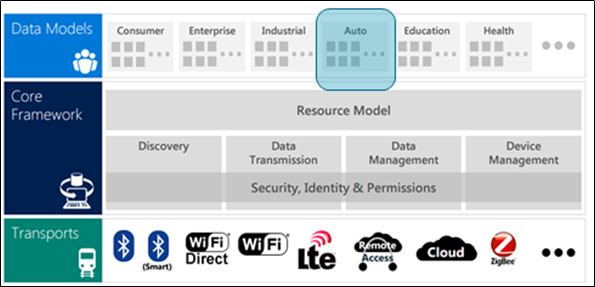...
c. A vendor neutral certification program: OCF certification
IoTivity
The IoTivity project was created to bring together the open source community to accelerate the development of the framework and services required to connect these billions of devices. The IoTivity project is sponsored by the Open Connectivity Foundation (OCF), a group of industry leaders who will be developing a standard specification and certification program to address these challenges. IoTivity will deliver an open source reference implementation of the OCF standard specifications, yet will not be limited to those requirements. IoTivity is licensed under Apache 2.0 and follows a well-defined open source development model and release cycle.
IoTivity has already been ported to a multitude of OS platforms including Linux (ex. Ubuntu), Android and Tizen and it has been verified on multiple developer reference hardware devices like Arduino, Raspberry Pi, smartphones (Android and Tizen), wearable devices (like Gear S2). IoTivity supports multiple programming languages like Java, C/C++, Javascript (nodejs) etc. For resource constrained devices running on low power MCUs, IoTivity has an alternative implementation of the core OCF specifications known as “iotivity-constrained”.
IoTivity Architecture
The IoTivity architecture can be classified into three layers.
- The Transport Abstraction layer abstracts the wired/wireless connectivity details for different hardware and software platforms and presents a unified API to enable secure Device-To-Device communications between OCF devices in a transport agnostic way.
- The core framework implements the core OCF protocol as defined in the OCF specifications and handles core functions like security, device discovery, data transmission and management and device provisioning.
- The data models help represent the individual devices and their capabilities as resources, as defined in the OCF specifications, that can be securely controlled other OCF devices in the network.
An elaborate description of OCF and IoTivity is outside the context of this report. Please refer to the references section for a more details.
The OCF Automotive Project
The automotive domain has been one of the key areas of focus for OCF since the beginning and as consumers start expecting their “connected vehicle” to be part of a seamless experience that depends on how the vehicle operates in a smart ecosystem involving a smart home, smart infrastructure and even with other vehicles.
In the words of Bill Ford (https://www.ted.com/talks/bill_ford_a_future_beyond_traffic_gridlock)
“We are going to build smart cars, but we also need to build smart roads, smart parking, smart public transportation systems and more... We need an integrated system that uses real time data to optimize personal mobility on a massive scale without hassle or compromises for travelers.”
Optimizing personal mobility, is no longer about the connected vehicle alone. To unlock these opportunities, OCF launched the Automotive Project in August 2016. The aim of the Project is to provide the technology, standards and collaboration needed to ensure secure interoperability between automotive and other verticals, starting with consumer electronics, smart home and healthcare. The initial use cases enabled by the project fall into the following broad categories.
Home Energy Management
Security System Interaction
Vehicle Location
Smart Home device status
Vehicle Control from Smart Device
Smart Device Control from Vehicle
Smart Mobility service integration
The Project will be driven by members from Samsung, Honeywell, Cisco, SmartThings, ETRI, GRL and Tinnos. The project will also closely collaborate with other OCF working groups, leading automotive companies and alliances, open source projects and standards bodies. The OCF Automotive Project will define the data models. Additionally, the group will drive the certification requirements for compliant bridging implementations, which is essential for realizing valuable and commercially attractive use cases, to the automotive industry. OCF's initial efforts to venture into the Connected Vehicle space involved analysis of the "Connected Vehicle – Smart Home" crossover use cases based on consumer interests and strategy reports. We consolidated the list of use cases under the following broad categories.
...
